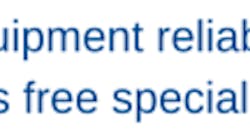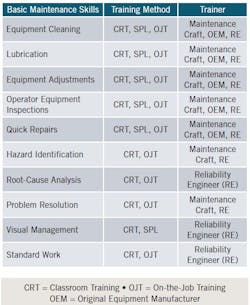How (and why) to train operators on maintenance
Although some maintenance activities require formal classroom training, many routine tasks can be taught to equipment operators internally using manufacturers’ instruction manuals and in-house subject-matter experts. Maintenance craftspeople are often an underutilized resource for cross-training operators, and on-the-job (or OTJ) training is the best knowledge-transfer method.
Operator maintenance activities make use of the knowledge and skills of the people who work with the equipment routinely and give operators a vested interest in equipment reliability. Operator care tasks also free up maintenance craftspeople for more proactive maintenance (i.e., preventive and predictive maintenance).
However, before they can delve into more specialized tasks, operators need to be trained to clean and inspect equipment and perform basic maintenance tasks such as tightening fasteners. They also need to know when to reach out for help should the task appear beyond their capabilities. Involving operators and maintenance craftspeople in developing an asset management strategy can help an organization identify opportunities for training operators to perform maintenance.
Front-line reliability
Operators are closest to the process equipment and know when it’s running in a stable mode. Because they are on the front line, they are best positioned to identify and treat hazards. In demonstrating cleaning tasks, maintenance craftspeople teach operators how to inspect their equipment. Operator-led inspections are meant to identify symptoms of equipment failure with enough advanced warning that a maintenance technician can effectively troubleshoot the problem and take appropriate action. The criteria on the inspection sheets, or procedures, help the operator identify failure modes early enough to allow them to resolve problems themselves or plan and schedule corrective actions for more-qualified maintenance craftspeople to perform before equipment failure affects the value stream.
The earlier the operator can detect symptoms – whether using online monitoring tools or by calling upon his or her senses of sight, hearing, smell, and touch – the more time the organization has to plan and execute a repair. In some instances, simple actions can resolve the cause of distress. As shown in the flow chart below, operator inspections add a layer of protection against equipment failure, but these skills need to be developed. Maintenance craftspeople are the most appropriate personnel to train operators to perform maintenance tasks.
Hazard elimination and mitigation
Maintenance craftspeople, original equipment manufacturers (OEMs), and reliability engineering (RE) personnel all can be involved in training operators to identify adverse equipment conditions and symptoms of distress. This can be done through equipment cleaning and inspection and reinforced with single-point lessons (or SPLs). Again, operators are in the optimum position to respond to early equipment warning signs, but they need to know what to look for and how to respond. They need to acquire basic maintenance skills to return equipment to an operable condition or contain the effects of failure. Reliability near-misses and resolution actions should be shared at team and communication meetings.
Root-cause analysis
Reliability engineers should train operators to collect critical evidence when equipment fails and to perform simple “5 whys” analyses for daily problem-solving. When cleaning equipment, operators are also inspecting it and looking for sources of contamination, debris, and leaks. Maintenance craftspeople can help develop the troubleshooting abilities of operators to identify the source of specific contamination and leaks. Root-cause analysis (RCA) is fundamental to the cooperative efforts to achieve world-class reliability, and training is needed on several fronts.
minimum maintenance skills for operators
Operators should be skilled in basic maintenance activities because the operator is the first line of defense in keeping a machine online. If the operator understands the maintenance required for an asset, he or she will understand the value of that asset’s performance and what to expect out of it. Naturally, those best suited to train operators for front-line reliability activities are maintenance craftspeople who have the most experience working on that particular asset.
1. Front-line reliability: This empowers operators to be more proactive, self-reliant, and responsive to problems by performing front-line tasks such as cleaning, lubrication, adjustments, inspections, and quick repairs. Maintenance craftspeople train operators via on-the-job training.
- Equipment cleaning: Reveals hidden problems and aids reliability; addresses cleanliness and routine sanitation.
- Lubrication: Operators are trained to perform basic lubrication tasks.
- Adjustments: Operators are trained to make specific adjustments to equipment.
- Inspections: Operator equipment inspections enable operators to be the eyes and ears of maintenance by identifying defects early.
- Quick repairs: Operators resolve problems early using basic maintenance skills. Training provides technical guidance and hands-on experience to support quickly returning equipment to service.
2. Hazard identification: Through inspections, operators and maintenance technicians identify defects or adverse conditions.
3. RCA: The reason for finding the root cause(s) is to address the problem at its source so that it doesn’t occur again.
4. Problem resolution: Elimination of defects at the source, through RCA, and minimizing the impact of unplanned events. Operators resolve problems themselves or enter work requests to the CMMS.
5. Visual management: Visual controls on gauges, levels, meters, and pipes enable rapid transformation on the shop floor. Operators and technicians can quickly determine if equipment is running right, troubleshoot and diagnose the problem. Operator dashboards make it easy for workers on all shifts to maintain focus on front-line reliability.
6. Standard work: Standard work applies to any activity, task, or action that will recur regularly. Standardized work minimizes variability in execution and prevents equipment damage. The focus is on stabilizing the processes, procedures, and practices that directly affect reliability of the production operation and physical assets.
Training operators to perform basic maintenance
Training can be delivered through classroom and on-the-job training (OJT) and reinforced using single-point lessons (SPL). The SPL is a one-subject, one-sheet training method that reliability engineering personnel or a given department prepares and that focuses on a specific asset. Topics may include machine function, cleaning, lubrication, methods and criteria for inspection, quick repairs, and safety.
At every opportunity, explain the SPL to operators and encourage its use. Training of in-plant personnel to effectively utilize predictive maintenance technologies will require classroom training. However, the majority of skills necessary for front-line reliability are best taught through OJT and learning by doing. Single-point lessons provide a vehicle for learning about specific equipment defects or failures as well as their quick restoration to service. (See Table 1 for a training matrix for operator maintenance skills development.)
Visual controls
Visual controls help operators immediately recognize work standards and other important information as well as deviations from those standards. These can be taught to operators through OJT reinforced with SPLs. The goal is to get the appropriate information or standard as close to the point of action as possible. Examples of visual controls include:
- Match-marking torqued fasteners
- Marking (high and low) reservoir and tank levels
- Marking gauges with normal operating ranges
- Marking piping flow direction
- Color-coding content in piping and vessels
- Marking direction of rotation on drive and driven equipment
- Indicators to identify when filters need to be replaced
- Labeling each lube point and color-coding to identify lubrication
Conclusion
The skills developed during training enable equipment operators to maintain or improve overall equipment efficiency. To avoid a failure or to mitigate the impact of one, equipment operators must acquire the skills necessary to return equipment to optimum operating conditions. Most of these skills can be developed on-the-job via cross-training by maintenance craftspeople, OEM representatives, and reliability engineering personnel.




